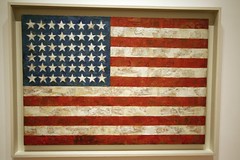Jasper Johns studied at the University of South Carolina from 1947 to 1948, a total of three semesters.[2] He then moved to New York City and studied briefly at the Parsons School of Design in 1949, says Wikipedia.[2]
While in New York, Johns met Robert Rauschenberg, with whom he had a relationship,[3] as well as Merce Cunningham and John Cage. Working together they explored the contemporary art scene, and began developing their ideas on art.
In 1958, gallery owner Leo Castelli discovered Johns while visiting Rauschenberg's studio.[2] Castelli gave him his first solo show. It was here that Alfred Barr, the founding director of New York's Museum of Modern Art, purchased four works from his exhibition.[1]
He is best known for his painting Flag (1954-55), which he painted after having a dream of the American flag.
His work is often described as a Neo-Dadaist, as opposed to pop art, even though his subject matter often includes images and objects from popular culture. Still, many compilations on pop art include Jasper Johns as a pop artist because of his artistic use of classical iconography.
Early works were composed using simple schema such as flags, maps, targets, letters and numbers. Johns' treatment of the surface is often lush and painterly; he is famous for incorporating such media as encaustic and plaster relief in his paintings.
Johns played with and presented opposites, contradictions, paradoxes, and ironies, much like Marcel Duchamp (who was associated with the Dada movement).
Johns' breakthrough move, which was to inform much later work by others, was to appropriate popular iconography for painting, thus allowing a set of familiar associations to answer the need for subject.
Though the Abstract Expressionists disdained subject matter, it could be argued that in the end, they had simply changed subjects. Johns neutralized the subject, so that something like a pure painted surface could declare itself.
For twenty years after Johns painted Flag, the surface could suffice - for example, in Andy Warhol's silkscreens, or in Robert Irwin's illuminated ambient works.
Sunday, November 1, 2009
Subscribe to:
Post Comments (Atom)





No comments:
Post a Comment